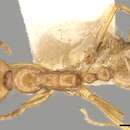en
names in breadcrumbs


Taxonomic history
Forel, 1918a PDF: 720 (m.).See also: Shattuck, 2008a PDF: 30.(Figs 3-5, 19, 20, 25)
Aphaenogaster (Nystalomyrma) barbigula Wheeler , 1916: 221.
Types . Lectotype worker (here designated) from Sea Lake, Victoria, G. C. Goudie ( MCZC ); paralectotypes as follows: Yanco (6 workers, MCZC , examined), New South Wales; Adelaide (3 workers, MCZC , examined), Meningie (5 workers, MCZC , examined); Gawler and Karoonda to Peebinga, South Australia; Dongara (as Dongarra), Gooseberry Hill, Wallaby Island and Beverley, Western Australia; Sea Lake (16 workers, MCZC , examined; 1 worker, MVMA , examined), Victoria.
Diagnosis. Majority of hairs on venter of head located laterally and forming a distinct psammophore (Fig. 4); eye relatively small (EI less than 21, Fig. 19); scape relatively short (SI less than 106, Fig. 20); mandibular sculpture composed of regularly sized striations (Fig. 5); petiolar node (in dorsal view) approximately square. The presence of a psammophore will separate this species from all others except A. mediterrae and A. poultoni . It can be separated from these species as outlined in the key above.
Description. Posterior margin of head nearly flat in full face view, extending laterally of the occipital collar before passing through a distinct posterolateral corner into the lateral margin of the head. Majority of hairs on venter of head located laterally and forming a distinct psammophore, only scattered hairs on central portion. Mandibular sculpture composed of regularly sized striations. Erect hairs on mesosomal dorsum tapering to sharp points. Propodeal spines reduced to small denticles, or sometimes essentially absent. Petiolar node (in dorsal view) approximately square.
Measurements. Worker (n = 8). CI 84-92; EI 22-27; EL 0.23-0.27; HL 1.12-1.26; HW 0.97-1.16; ML 1.58-1.84; MTL 0.96-1.08; SI 104-115; SL 1.11-1.25.
Material examined (in ANIC unless otherwise noted). New South Wales: 12km S Coombah (Ward,P.S.) ( ANIC , PSWC ); 4mi. N Condobolin (Lowery,B.B.); 60mi. S Broken Hill (Lowery,B.B.); 7mi. S Hillston (Lowery,B.B.); Berrigan SF (Lowery,B.B.); Cocoparra NP, nr Griffith (Lowery,B.B.); Emu Vale, nr. Deniliquin(Greenslade,P.J.M. & Valentine,I.); Griffith, bank of Lake Wyangan (Lowery,B.B.); nr. Darling R., Wentworth(Lowery,B.B.); Lake Popilta [Popiltah Lake] (Lowery,B.B.). Queensland: 15 km S by W of Charleville (Upton,M.S.); 30km W St. George (Lowery,B.B.); Beralga c.50mi. NW St. George (Lowery,B.B.); St. George (Lowery,B.B.); St. George nr. Balonne R. (Lowery,B.B.). South Australia: 15km NW Renmark (Shattuck,S.O.); 18km NNE Meninjie (Greenslade,P.J.M.); 30mi. S Whyalla, Moonabie Ra. (Haycraft,J., MCZC ); 32km N Renmark (Shattuck,S.O.); 40km S Oodnadatta (Lowery,B.B.); 5mi. W Tintinara (Greaves,T.); Blythe, 80mi. N Adelaide (Lowery,B.B.); Ferries McDonald Natl. Pk. (Shattuck,S.O.); Gawler Ra., Saline to SE (Greenslade,P.J.M.); Hambridge NP [Hambidge NP] (Britton,E.B.); Kokatha, Gawler Ranges (Greenslade,P.J.M.); Lochiel (Lowery,B.B.); Perponda (Greenslade,P.J.M.); Tailem Bend (Lowery,B.B.); Two Wells (Lowery,B.B.); Victoria Desert, 53km E Vokes Hill (Greenslade,P.J.M.); Warooka, Yorke Peninsula (Lowery,B.B.); Yorke Pen., Hardwicke Bay (Greenslade,P.J.M.). Victoria: 20mi. NW Swan Hill (Greaves,T.); Bannerton Mallee (Nilson,A.C.); Bendigo (Greenslade,P.J.M.; Lee,K.E.); Ouyen.
Comments. This species occurs in semi-arid areas of eastern South Australia, south-central Queensland, western New South Wales and north-western Victoria (Fig. 25). It is generally found in forested habitats including Callitris and mulga (Acacia sp.) woodlands (including on red soils), mallee (with and without Triodia(spinifex grass)) and in savannah woodlands, but is occasionally found in grasslands, especially with scattered trees. It is most often found on sandy soils. Nests are always in soil and almost always have large, deep craters around the entrance. The biology of this species was discussed by Crawley (1922a: 122).